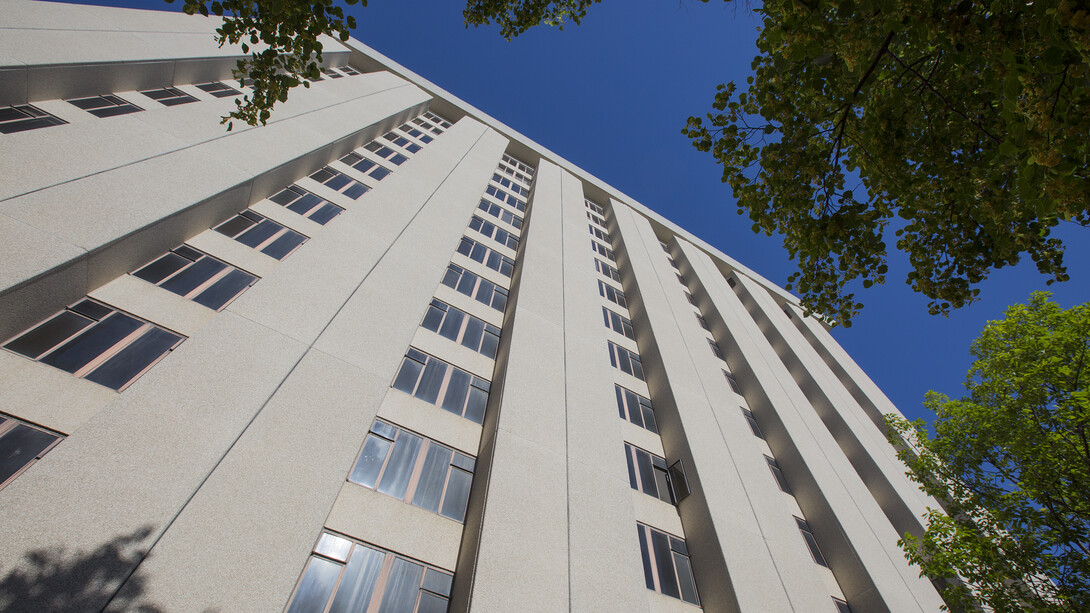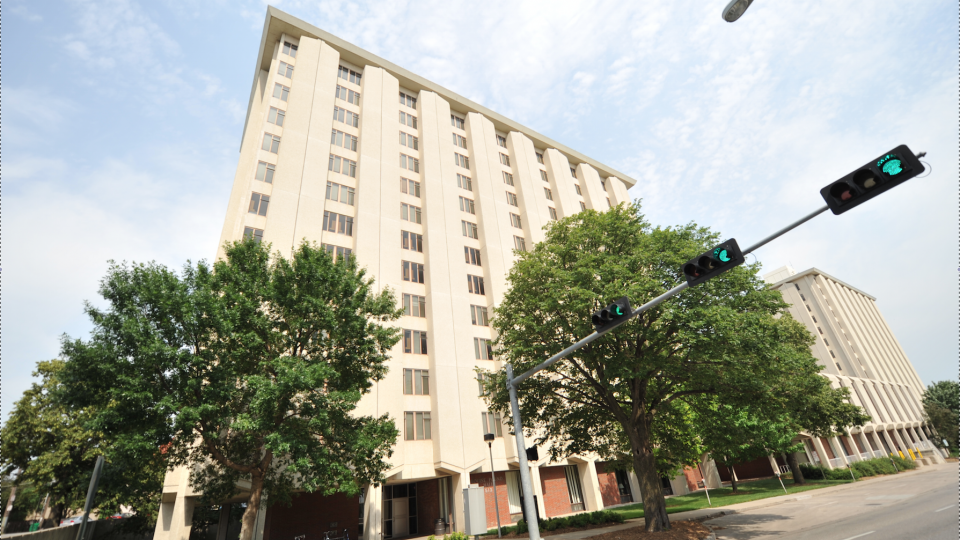
After nearly two years of planning and consultation, final details are coming into focus on the demolition of the University of Nebraska–Lincoln’s oldest high-rise residence hall complex.
Built in 1963, Cather Hall, Pound Hall and the Cather-Pound Dining Center will be razed through two methods — first by knocking down and removing the dining center with heavy construction equipment in November, then by imploding the two 13-story residence hall towers into the vacated dining center space.
Prep work on the facility started in May. Implosion of the buildings is targeted for late December when campus activity is reduced between the fall and spring semesters. Demolition cleanup and site restoration are anticipated to extend through July 2018.
Delays in building preparation could shift the implosion until after the end of the spring semester in May 2018. In that event, project completion extends to fall 2018.
“Due to safety concerns, the best time to complete demolition is when there is reduced student, faculty and staff activity on campus,” said Sue Gildersleeve, director of housing. “Our goal is to complete that process later this year during the semester break. However, we will wait if there are unforeseen conditions or delays in the preparation process.”

Cather and Pound halls are located along North 17th Street, with the two-story dining facility in the middle, connecting the two towers. The Board of Regents unanimously approved a $7.3 million funding request for the demolition on Nov. 18, 2016.
In 2010, an independent study of Cather and Pound identified life safety, building code and exterior façade deficiencies, and that renovation of the buildings was not recommended due to extremely high cost.
Both towers were scheduled to be taken off line in 2013, but remained open to accommodate larger-than-expected demand for on-campus housing. Cather Hall closed in 2014 and Pound Hall remained in service through the 2016-17 academic year.
While demand for on-campus housing remains strong, the need for the aging towers has been reduced since 2013 with the addition of two suite-style halls, University Suites and Eastside Suites, and the opening of the new Willa Cather Dining Center this summer.
“At the end of the day, we had to make a decision on what would be the best value for our students,” Gildersleeve said. “Student demand for suite-style housing coupled with the high cost to renovate Cather and Pound ultimately made new construction and the demolition of these two facilities the best option.”
Demolition preparations will expand to the exterior of the Cather-Pound complex in late June.
“To accommodate the significant building preparation process, traffic lanes on 17th Street have closed,” said Brooke Hay, assistant director of facilities planning and construction. “Moving forward, some of the work will be visible and other work will be internal to the building.
“The project will culminate with the implosion, followed by a large effort to remove all of the rubble and restore the site.”
Within the next two weeks, work to remove the link between nearby Neihardt Hall and the Cather-Pound Dining Center, which has been closed since May, will begin. Other noticeable projects starting soon includes façade preparation and removal of major mechanical systems in basement areas. Work within the basement areas is expected to include exterior dirt excavation and the opening of foundation walls.
The university has also sought ways to repurpose or sell items previously used in the residence hall complex. Gildersleeve said beds and combination microwave/refrigerators have been sold through various websites, dining room tables and chairs were sold at a recent campus surplus inventory auction, and some food service equipment has been transferred to the Nebraska College of Technical Agriculture in Curtis.
“Our goal through this process is to repurpose or recycle as many items and materials as possible,” Gildersleeve said. “We’ve also worked closely with university partners and city officials to come up with the most cost-effective way to dispose of materials that cannot be reused.”
As the demolition moves forward, the university will announce details on the implosion date, plans to protect buildings near the towers, and how the public can safely watch the buildings fall. When the demolition and cleanup are complete, the Cather-Pound site will be converted into green space. The university does not have immediate plans for a new building on the site.
Overall, housing officials said the process to raze the Cather-Pound complex has been a rewarding team effort between university units, city offices, consultants and federal organizations. Along with housing, key campus units that have contributed include facilities planning and construction, environmental health and safety, and inventory.
“This has been an exhaustive two-year process of educating ourselves, exploring various options, and finding the safest and most cost-effective method to bring down these buildings,” said Brian Shanks, associate director of housing business and fiscal operations. “Now, excitement is building as we continue to finalize details.
“It is going to be very rewarding to see all of this work between university and off-campus partners come together for the safe removal of these buildings.”
For more information about the Cather-Pound demolition project, click here.







